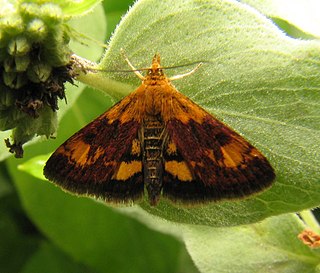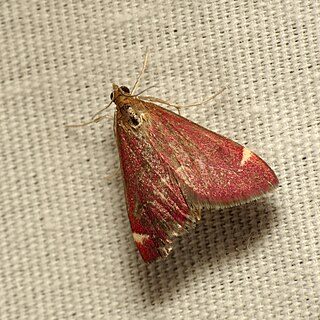
Pyraustinae is a large subfamily of the lepidopteran family Crambidae, the crambid snout moths. It currently includes over 1,400 species, the majority of them tropical but some found in temperate regions including both North America and Europe.

Pyrausta is a specious genus of moths of the family Crambidae. The genus was erected by Franz von Paula Schrank in 1802.

Pyrausta orphisalis, the orange mint moth or orange-spotted pyrausta, is a species of moth of the family Crambidae. It was described by Francis Walker in 1859. It is found in North America from Newfoundland west to British Columbia, south to Florida and New Mexico.
Pyrausta andrei is a moth in the family Crambidae. It was described by Munroe in 1976. It is found in North America, where it has been recorded from Texas.
Pyrausta antisocialis is a moth in the family Crambidae. It was described by Munroe in 1976. It is found in North America, where it has been recorded from New Mexico and Arizona.
Pyrausta arizonicalis is a moth in the family Crambidae. It was described by Munroe in 1976. It is found in North America, where it has been recorded from Texas, New Mexico and Arizona.
Pyrausta californicalis, the California pyrausta moth, is a moth in the family Crambidae. It was described by Alpheus Spring Packard in 1873. It is found in North America, where it has been recorded from British Columbia to California.
Pyrausta fodinalis is a moth in the family Crambidae. It was described by Julius Lederer in 1863. It is found in North America, where it has been recorded from British Columbia to Quebec and the north-eastern United States. It is also present in California, Nevada, Colorado and Wyoming. The habitat consists of undisturbed prairie and grassland areas.

Pyrausta grotei is a moth in the family Crambidae. It was described by Eugene G. Munroe in 1976. It is found in North America, where it has been recorded from Washington, Oregon, Montana, California, Utah, Colorado, Wyoming, Nevada, Arizona and Texas.
Pyrausta homonymalis is a moth in the family Crambidae. It was described by Eugene G. Munroe in 1976. It is found in North America, where it has been recorded from Missouri to Virginia, Mississippi and Florida, west to Texas.
Pyrausta perrubralis is a moth in the family Crambidae. It was described by Packard in 1873. It is found in North America, where it has been recorded from British Columbia, California, New Mexico, Oregon and Washington.

Pyrausta pseuderosnealis is a moth in the family Crambidae. It was described by Eugene G. Munroe in 1976. It is found in Mexico and the United States, where it has been recorded from California, Texas, Florida, Alabama, Georgia, Iowa, Mississippi, South Carolina, Louisiana, Arkansas, Missouri, Illinois and Oklahoma.
Pyrausta pseudonythesalis is a moth in the family Crambidae. It was described by Munroe in 1976. It is found in North America, where it has been recorded from California, Nevada, Arizona, New Mexico and Texas.
Pyrausta retidiscalis is a moth in the family Crambidae. It was described by Eugene G. Munroe in 1976. It is found in North America, where it has been recorded from Texas.
Pyrausta roseivestalis is a moth in the family Crambidae. It was described by Eugene G. Munroe in 1976. It is found in North America, where it has been recorded from California and southern Arizona.
Pyrausta scurralis is a moth in the family Crambidae. It was first observed and described by George Duryea Hulst in 1886. It is found in North America, where it has been recorded/reported in the Canadian provinces of Ontario, Manitoba and Saskatchewan to the US states, California, Arizona, and New Mexico and in Mexico. The habitat consists of undisturbed, shrubby aspen parkland.
Pyrausta shirleyae is a moth in the family Crambidae. It was described by Munroe in 1976. It is found in North America, where it has been recorded from Florida.
Pyrausta socialis, the sociable pyrausta moth, is a moth in the family Crambidae. It was described by Augustus Radcliffe Grote in 1877. It is found in North America, where it has been recorded from Ontario west to British Columbia, south to Montana and Colorado.
Pyrausta subgenerosa is a moth in the family Crambidae. It was described by Munroe in 1976. It is found in North America, where it has been recorded from California.
Pyrausta subsequalis is a moth in the family Crambidae. It was described by Achille Guenée in 1854. It is found in North America, where it has been recorded from southern Alberta and southern British Columbia south to Arizona and New Mexico. The habitat consists of dry prairie areas.






